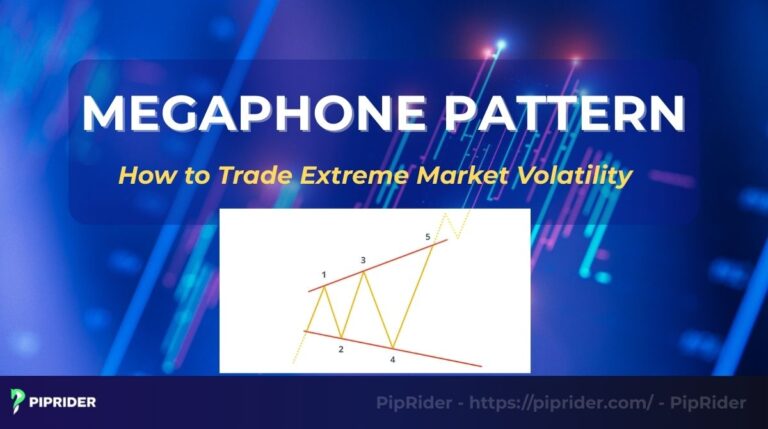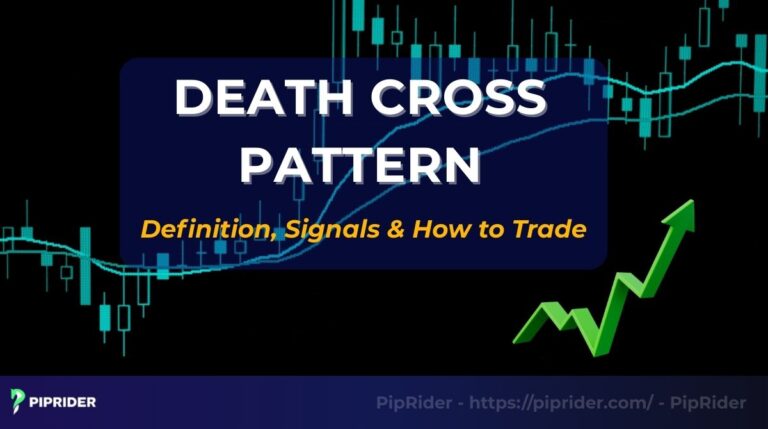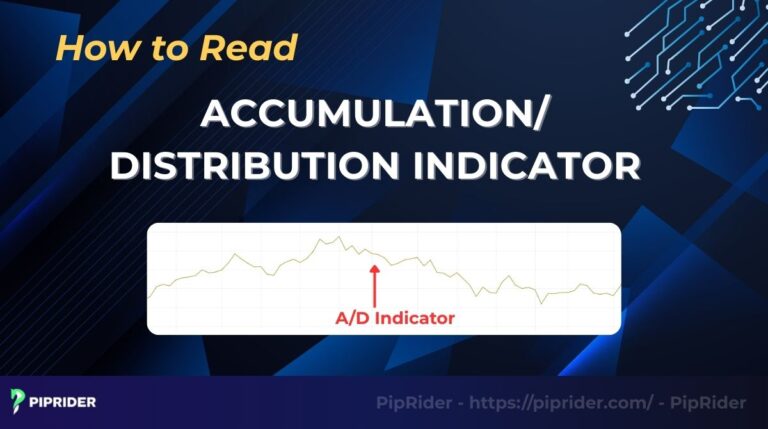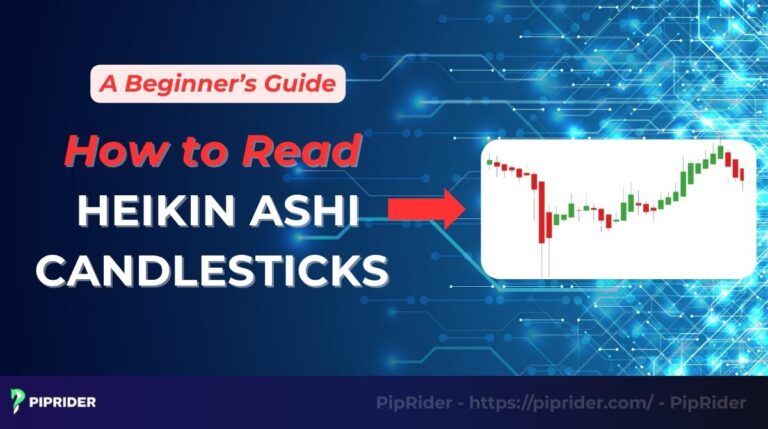The Money Flow Index (MFI) is a powerful momentum indicator that measures the intensity of money flowing into and out of an asset by combining both price and trading volume. This unique, volume-weighted approach provides a more reliable confirmation of market strength than pure price oscillators like the RSI.
This guide details the MFI indicator‘s calculation, explains its high-probability signals, and shows you how to integrate it into a profitable trading strategy.
Key Takeaways
- MFI is the volume-weighted RSI; it measures momentum using both price changes and trading volume.
- MFI is derived from comparing Positive Money Flow (buying) to Negative Money Flow (selling) over a 14-period default setting.
- Prioritize divergence (MFI and price moving against each other) and the overbought/oversold levels (above 80 and below 20) for trade signals.
- MFI is generally more reliable than RSI in high-volume markets because the volume component filters out weaker, less-supported price movements.
- Use MFI to confirm trend strength and identify high-probability reversals at market extremes.
1. What Is the Money Flow Index (MFI)?
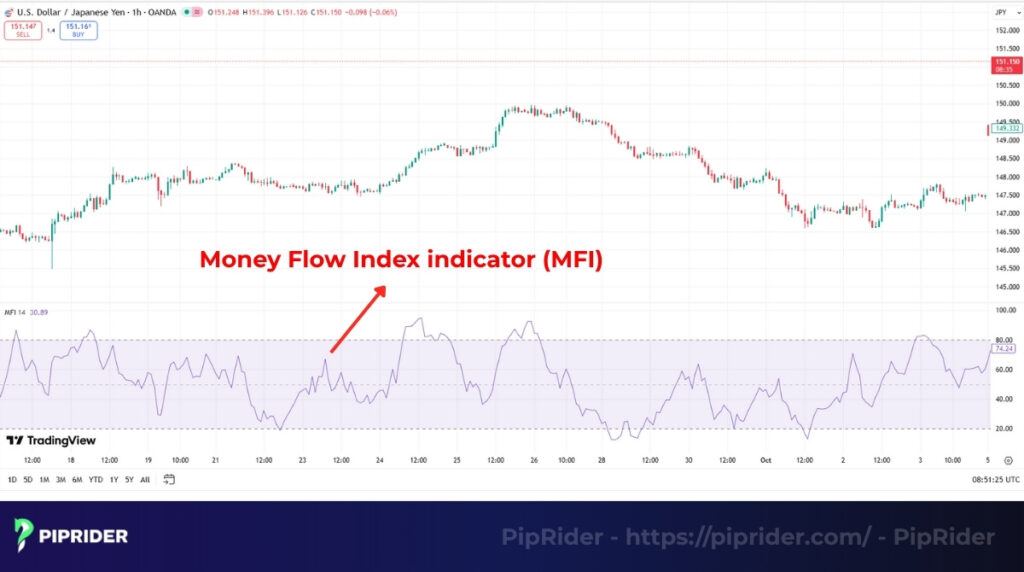
The Money Flow Index (MFI) is a technical indicator used to measure the intensity of capital flowing into and out of a security, based uniquely on both typical price and volume data over a set period (Investopedia, n.d.).
As the “money flow indicator,” the MFI serves as a powerful supplementary tool that actively helps investors accurately identify overbought and oversold market conditions.
The MFI typically oscillates between 0 and 100, with the 80 and 20 thresholds commonly marking the overbought and oversold regions. This indicator highlights the strength and conviction of a price trend through the use of volume data, unlike pure price oscillators such as the Relative Strength Index (RSI).
For example, an MFI reading above 80 for a stock suggests it may be overbought, signaling a potential price correction ahead.
MFI is often referred to as the “RSI with Volume” because its calculation structure mirrors the RSI, but it assigns weight to price changes based on the trading volume. Financial studies and expert analysis confirm that integrating volume allows the MFI to provide more reliable insights into potential price reversals.
2. Understanding the MFI Formula
The MFI formula is a sophisticated process that ensures volume directly weights the momentum calculation. The rigorous multi-step calculation provides a far better reflection of market dynamics than indicators relying solely on price.
2.1. MFI Calculation Steps
According to IG International, the MFI indicator calculation involves a structured five-step process, which is integrated into all popular technical analysis software:
Step 1: Calculate Typical Price (TP)
This step establishes the average price movement for a given period.
Typical Price (TP) = (High + Low + Close) / 3
Step 2: Calculate Raw Money Flow (RMF)
Raw Money Flow quantifies the total capital traded in that period.
Raw Money Flow (RMF) = Typical Price × Volume
Step 3: Classify Money Flow
This step separates capital inflow from capital outflow over the designated lookback period (e.g., 14 days).
- Positive Money Flow: The sum of RMF for all periods where the Current TP > Previous TP.
- Negative Money Flow: The sum of RMF for all periods where the Current TP < Previous TP.
Step 4: Determine Money Flow Ratio (MFR)
This ratio compares the total buying pressure to the total selling pressure within the measured period.
Money Flow Ratio (MFR) = Total Positive Money Flow / Total Negative Money Flow
Step 5: Final MFI Formula
The final formula converts the ratio into an oscillator scale ranging from 0 to 100.
Money Flow Index (MFI) = 100 − (100 / (1 + Money Flow Ratio))
This verified formula accurately integrates price and volume, significantly improving the quality of market analysis for investors.
2.2. Example of MFI Calculation
To illustrate the mechanism, consider a 3-day example focusing on the Money Flow Ratio (MFR), using hypothetical data:
| Day | High | Low | Close | Volume | TP (H+L+C)/3 | Previous TP | RMF (TP x Vol) | Flow Type |
| 1 | 105 | 100 | 104 | 50,000 | 103 | (N/A) | 5,150,000 | N/A |
| 2 | 107 | 103 | 106 | 70,000 | 105.33 | 103 | 7,373,100 | Positive |
| 3 | 106 | 102 | 103 | 60,000 | 103.67 | 105.33 | 6,220,200 | Negative |
Calculation Steps (Based on Day 2 & 3):
- Total Positive Money Flow (Day 2) = 7,373,100
- Total Negative Money Flow (Day 3) = 6,220,200
- Money Flow Ratio (MFR) = 7,373,100/6,220,200≈1.185
- MFI = 100−(100/(1+1.185))≈100−45.76≈54.24
A resulting MFI of 54.24 indicates a slight bias toward capital inflow (buying pressure) in the market over this short period.
3. How the MFI Indicator Works
The Money Flow Index (MFI) is a momentum gauge that translates price and volume data into a single line. This process clarifies the true investor conviction of capital movement in the stock market money flow.
The MFI works by first calculating Raw Money Flow (RMF): Typical Price (TP) multiplied by Volume. This crucial step ensures high trading volume is needed to generate a strong signal. RMF is then classified as Positive Flow (buying) or Negative Flow (selling) based on whether the TP rose or fell.
The final MFI value directly reflects the market’s power balance.
- A rising MFI means Positive Money Flow dominates (money flows into the asset, confirming strong buying).
- A falling MFI means Negative Money Flow dominates (capital flows out, confirming strong selling). This defines market sentiment.
The MFI operates on an oscillator scale from 0 to 100. The center line (50) is the neutral point. The critical signal zones are the extremes: Above 80 signals the Overbought region (potential exhaustion); Below 20 signals the Oversold region (potential rebound).
4. Interpreting MFI Signals
Interpreting the MFI involves analyzing both the extreme levels of the oscillator and, more importantly, the relationship between the MFI line and the price structure.
4.1. Overbought and Oversold Levels
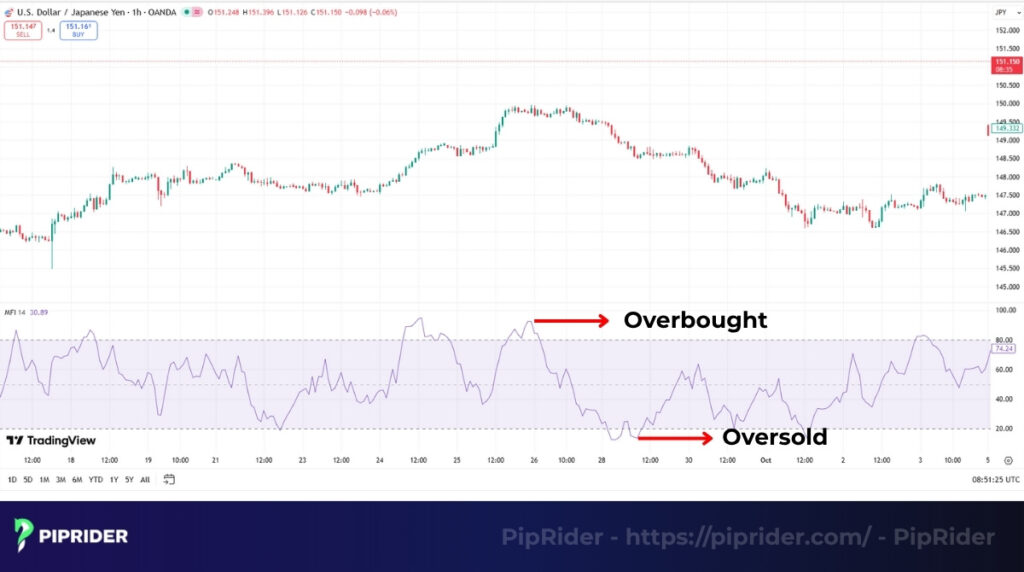
MFI extreme readings serve as an early warning system for potential trend exhaustion:
- Overbought (Above 80): Readings above 80 signal that capital inflow has become excessive and the asset may be nearing a price peak or correction. Traders prepare for a reversal or consolidation, indicating potential market shifts.
- Oversold (Below 20): Readings below 20 signal that capital outflow has become excessive, indicating potential panic selling and that the asset may be due for a rebound or bullish reversals. This helps monitor price changes.
4.2. Divergence (Price and MFI)
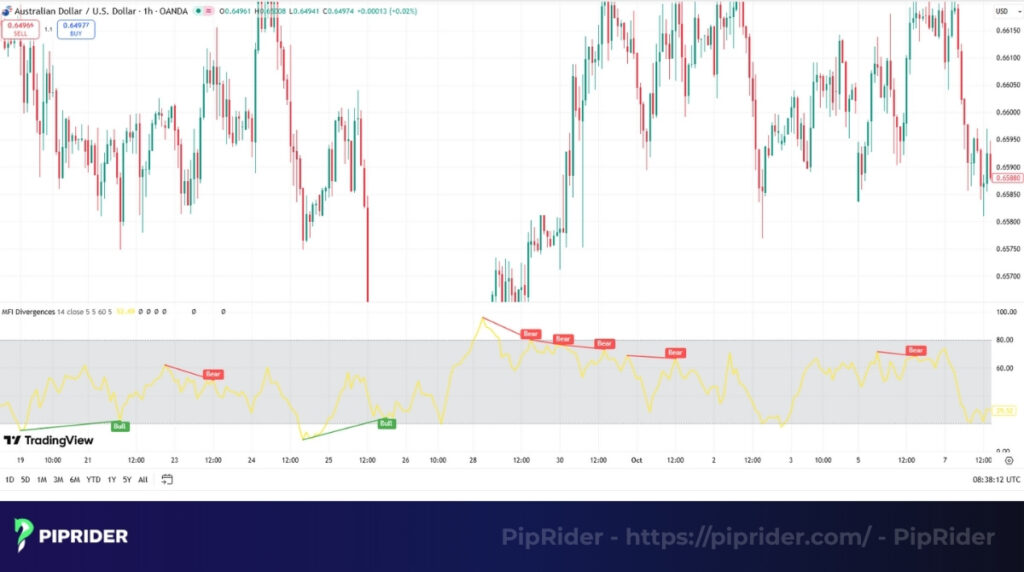
Divergence is the most valuable and reliable MFI signal, as it foreshadows reversals by showing a mismatch between price and the underlying money flow.
- Bearish (Negative): Occurs when the price records a higher high, but the MFI registers a lower high. This suggests that despite the rising price, buying interest is waning (money flow is decreasing), signaling a potential bearish reversal.
- Bullish (Positive): Occurs when the price records a lower low, but the MFI registers a higher low. This indicates that selling pressure is tiring out while accumulation is quietly beginning beneath the surface, signaling a potential bullish reversal.
Always seek confirmation when trading MFI signals. A divergence signal is significantly stronger if it is validated by a decisive change in volume (e.g., increased volume on the confirmation candle) and subsequent price action (e.g., a break of a trendline or a strong reversal candlestick pattern).
5. How to Use the MFI in Trading
Trading the MFI indicator effectively involves prioritizing high-conviction signals like divergence and integrating risk management and other technical tools.
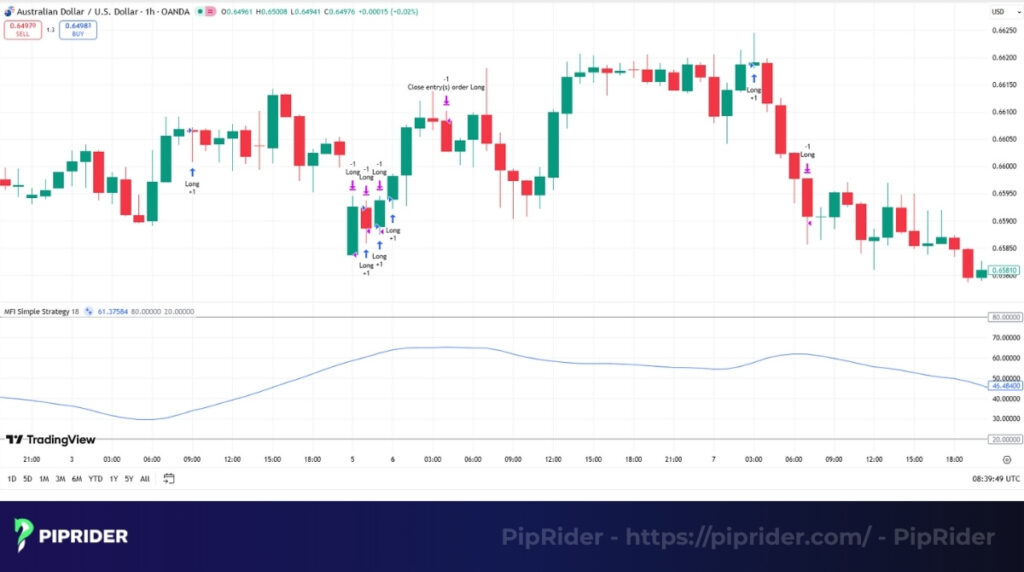
5.1. Identifying Entry and Exit Points
The most reliable entry and exit signals are generated by MFI Divergence near key structural levels.
- Entry: Enter a long position when a bullish divergence forms near a major support zone. Enter a short position when a bearish divergence forms near a major resistance zone. The price must confirm the reversal with appropriate price action (e.g., a break of a short-term trendline).
- Exit (Take Profit): Use MFI extreme levels as potential exit cues. For a long trade, an MFI reading crossing above 80 suggests it’s time to take profits. For a short trade, an MFI reading dropping below 20 signals potential exhaustion.
5.2. MFI Strategy Examples
The MFI is highly adaptable to various trading styles due to its volume component:
- Swing Trading: Use the daily or 4-hour charts. Look for MFI divergence confirmed at major support/resistance. The MFI helps you catch the beginning of large swings where money flow is turning.
- Scalping: Combine the MFI (set to a shorter lookback period, e.g., 10) with a moving average like the Exponential Moving Average (EMA) on lower timeframes (e.g., 5-min). Enter trades when the price crosses the EMA, only if the MFI confirms the move (e.g., MFI is trending strongly toward 50 or showing short-term divergence).
Read more: Top 12 best indicators for scalping forex
5.3. Stop Loss & Risk Management
Effective risk management is crucial, as MFI can give early signals that require careful handling:
- Stop Loss Placement: Place the Stop Loss (SL) outside the consolidation or swing high/low that caused the MFI divergence.
- Managing Early Signals: MFI can enter the overbought/oversold zones (80/20) long before the price reverses. Never trade solely based on 80/20 thresholds. Wait for MFI to turn back toward the neutral 50 line AND for the price action to confirm the reversal (e.g., a bearish candlestick pattern) before executing the trade.
6. Combining MFI with Other Indicators

No single indicator is perfect. Combining the volume-weighted MFI with other tools significantly increases signal reliability and filters out market noise.
- MFI + RSI (Dual Momentum): Use both indicators to confirm divergence. If a signal appears on MFI (volume-weighted momentum) and RSI (pure price momentum), the signal is exceptionally strong and reliable.
- MFI + Bollinger Bands (Breakout Filter): Use the MFI to validate breakouts. If the price breaks the band but the MFI fails to follow or shows divergence, it signals a fake breakout (whipsaw) due to a lack of volume support.
- MFI + MACD (Trend Confirmation): Use the MACD to establish the direction of the larger trend. Only execute MFI signals that are aligned with the MACD’s prevailing trend to ensure you are trading high-conviction market shifts within a confirmed structure.
7. Best Settings for the MFI Indicator

Choosing the right lookback period for the MFI indicator is crucial, as the default setting may not suit all trading styles.
- Default and Customization (Period): The standard period setting is 14, which provides a balanced view for most daily and 4-hour charts. For scalping (H1 or lower), consider reducing the period (e.g., 6 to 10) to increase sensitivity and catch faster signals. For position trading (weekly or monthly charts), use a longer period (e.g., 20 or 25) to smooth out noise and focus on long-term conviction.
- Optimizing Thresholds: While 80 and 20 are the standard overbought/oversold levels, experienced traders often use 90 and 10 to filter for only the highest-conviction reversals. This refinement is especially useful for filtering noise in volatile markets like cryptocurrency.
- Caution Against Overfitting: Never optimize the MFI period based solely on historical data (backtesting) to fit past market movements perfectly. This practice, known as overfitting, creates a system that performs flawlessly in the past but fails dramatically in live trading environments. Use optimization to balance sensitivity with lag, not to eliminate losses.
8. MFI vs RSI: What’s the Difference?
The MFI and the Relative Strength Index (RSI) are both momentum oscillators that measure the speed and change of price movements. However, they rely on fundamentally different inputs.
The MFI gains a significant advantage by integrating volume, which acts as a crucial confirmation filter. This allows traders to gauge whether a price movement is supported by actual capital flow or just thin trading.
| Aspect | Money Flow Index (MFI) | Relative Strength Index (RSI) |
| Input Data | Price + Volume | Price only |
| Indicator Type | Volume-Weighted Oscillator | Pure Momentum Oscillator |
| Signal Reliability | Stronger in high-volume markets; volume filters weak moves. | Better for quieter markets or assets lacking reliable volume data. |
| Ideal Use | Highly liquid financial markets like Forex, Stocks, and Crypto (where volume is robust). | Indices, currencies (interbank volume estimates), or low-volume assets. |
| Primary Focus | Money Flow/Capital Conviction | Speed and Magnitude of Price Change |
9. Advantages and Limitations of the MFI Indicator
The MFI’s construction offers significant benefits, but traders must acknowledge its inherent drawbacks, particularly regarding data quality.
9.1. Advantages
Understanding the core benefits helps integrate the MFI effectively into a technical analysis framework for higher conviction signals.
- Higher Reliability: By combining price and volume, the MFI provides signals more reliable than pure price oscillators like the RSI, as volume acts as a fundamental confirmation filter.
- Confirmation Tool: Excellent for confirming breakouts (supported by money flow) and identifying trend exhaustion at market extremes.
- Versatility: Functions well in both trending and sideways (ranging) markets.
9.2. Limitations
Being aware of the MFI’s weaknesses is vital for mitigating risk and avoiding trades based on potentially inaccurate data.
- Lagging in Volatility: The MFI can be lagging (delayed) during sharp, high-velocity price movements, leading to slow entry or exit signals.
- Volume Data Quality: It can generate false signals in markets where reported volume is not centralized or genuine (e.g., Crypto CFDs where the underlying volume is approximated).
10. Practical Tips for Using MFI
To maximize the effectiveness of the MFI and filter out noise, traders should adhere to these practical rules, learning how to track money flow in stock market:
- Avoid Trading Only 80/20 Thresholds: Never trade solely based on MFI reaching 80 or 20. MFI can stay in these regions for extended periods during strong trends. Always wait for the MFI line to actually reverse toward the 50 neutral line, confirmed by market price movement.
- Prioritize Divergence + Volume Confirmation: Divergence is the MFI’s highest-conviction signal. Traders should always prioritize it over simple overbought/oversold readings. Only enter the trade when this powerful signal is confirmed by a spike in volume and a clear reversal candlestick pattern.
- Utilize Multiple Timeframe Analysis (MTFA): Use longer timeframes (daily, H4) to establish the major trend and key support/resistance levels. Then, use the MFI signal on the shorter timeframe (H1, M30) to pinpoint the precise entry, dramatically reducing false signals.
11. Frequently asked questions about MFI Indicator
12. Conclusion
The MFI indicator is an indispensable tool in technical analysis, providing a unique volume-weighted view of market momentum. Its primary role is to gauge the true conviction behind price moves.
MFI is best used to confirm trends and identify high-probability trend reversals using divergence. Never trade MFI in isolation; always combine it with indicators like RSI (for dual momentum) or support/resistance (to filter false breakouts).
Avoid overfitting the MFI period during backtesting; always prioritize confirmation from volume and price action before entering trades. To enhance your skills, follow the Intermediate and Broker Reviews sections of Piprider.



